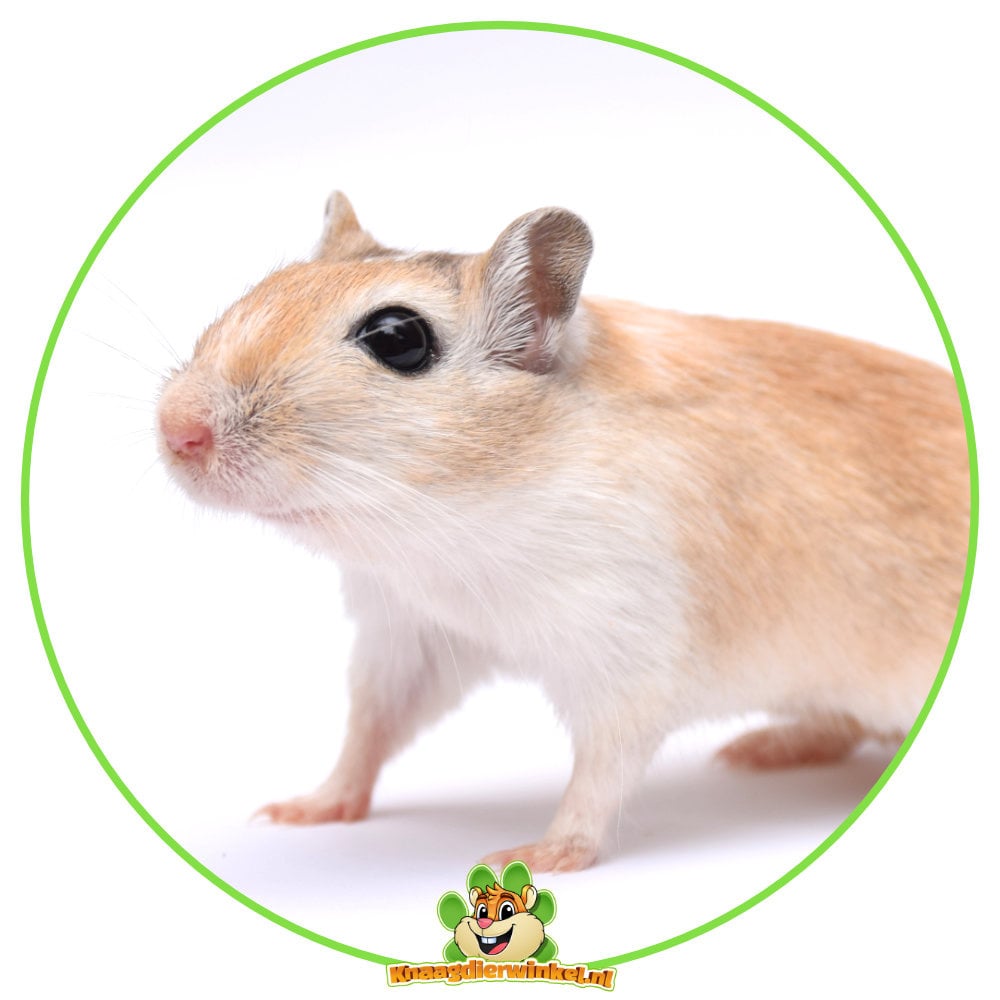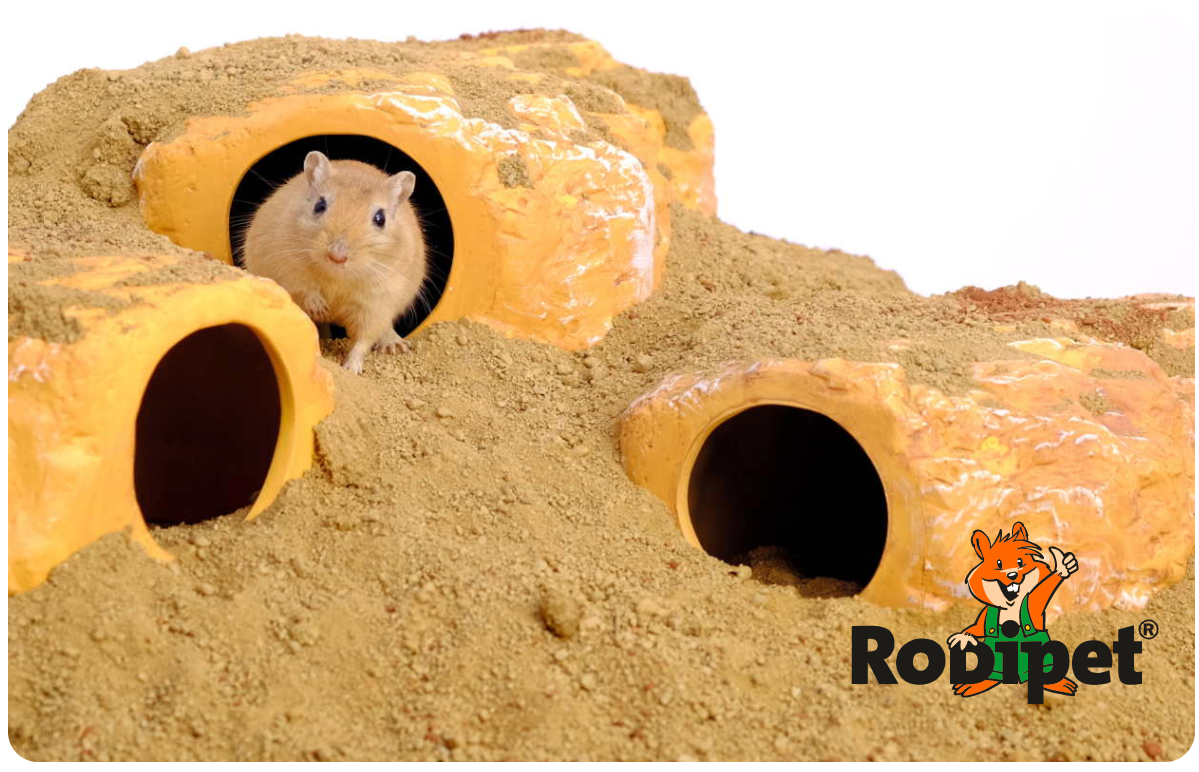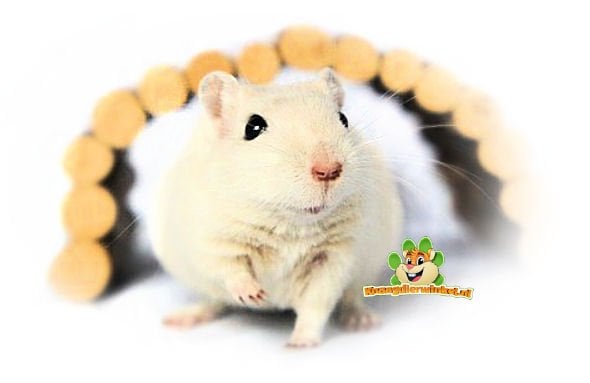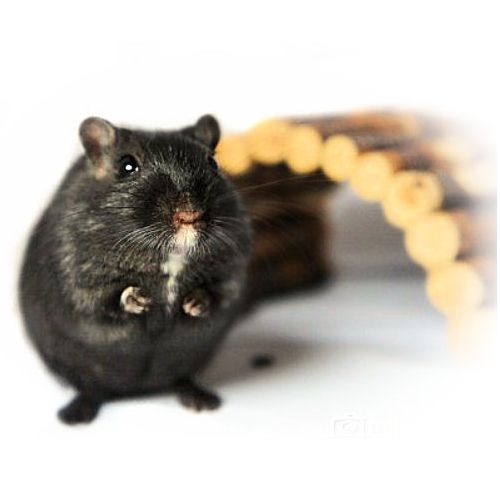 Mongolian Gerbil
Mongolian Gerbil
The Mongolian Gerbil (Meriones unguiculatus) is also called "desert rat" and that is because it lives naturally in the desert. The Mongolian Gerbil is a friendly and social animal that lives in family groups. In the wild, the animals live in (semi) deserts of Mongolia.
Head-body length : 10 to 12 cm
Body weight : 70 - 130 grams
Life expectancy : 3 - 5 years
Gerbils are very active animals that love to dig and gnaw. It is therefore important that the enclosure is set up for digging and that all components are gnaw-proof (aluminium/metal) or gnawable (wood). Plastic is best not used with these animals.
Taming and familiarizing yourself with the Mongolian Gerbil
Always read up on the subject before you decide to get Mongolian Gerbils. They are very nice pets that are often awake, so they can also be seen during the day. This can be especially nice for children. Mongolian Gerbils are very friendly and curious, but they are not cuddly animals, they do not like to be held. However, after a while they will gladly come to your hand to take a treat and they actively make contact with their owner. Mongolian Gerbils are very fast, which makes them sometimes difficult to handle, especially for children. It is therefore important that there is always a parent present who can help and support when children handle the animals.
New residents should be approached calmly, especially at first. The animals must first become familiar with their own habitat and feel safe there before they dare to approach people. Of course, there are also daredevils who immediately approach you and are social, but most Gerbils are still a bit shy at first. Give the animals time and try to make contact calmly by talking to them. Giving them a treat from your hand often works well to gain the animals' trust.
Tip! Mongolian Gerbils love pumpkin seeds!
Housing the Mongolian Gerbil
 Mongolian Gerbils are social animals that need to be kept together. In the wild, they live in colonies with a strict hierarchy. The best combination consists of two animals of the same sex, for example two males or two females. At a young age, the animals are quite easy to pair, but at an older age this is a lot more difficult.
Mongolian Gerbils are social animals that need to be kept together. In the wild, they live in colonies with a strict hierarchy. The best combination consists of two animals of the same sex, for example two males or two females. At a young age, the animals are quite easy to pair, but at an older age this is a lot more difficult.
Mongolian Gerbils need a spacious enclosure of at least 100 x 50 cm for two animals. For each additional animal, 20% - 25% extra ground surface must be calculated. A good enclosure gives the animals the opportunity to show their natural behavior. In the wild, Gerbils build beautiful tunnel systems and they want to continue to do so in captivity. The Gerbil has an extensive tunnel system. The burrow in the wild is at a depth of approximately 1 meter. The depth of the burrow depends on the ambient temperature. When the temperature rises, the gerbil will dig deeper underground to reach the cool earth, a kind of natural air conditioning.
Hamsterscaping is therefore a lot of fun for Mongolian Gerbils.
In our home this translates into a spacious enclosure with lots of digging possibilities and a sandbox. A terrarium is the best choice for this because of its closed character. It is important that a terrarium allows for good ventilation, so preferably has two grids (top and bottom). This is especially important in the summer when temperatures rise above 25°C.
A sandbox is important for Gerbils; as they are desert dwellers, they quickly develop a greasy coat.
Mongolian Gerbils do not tolerate high temperatures in combination with high humidity. They are desert dwellers by nature, which means they are not used to high humidity. An optimal humidity for these animals is around 55% on average. A temperature between 20 - 24°C is recommended and a humidity below 70%. You can use a hygrometer to measure these values.
House for Mongolian Gerbils
Mongolian Gerbils are lucky! because many houses that are made for Hamsters are also a good size for Gerbils. They are prey animals and do not like to walk around the enclosure in the open, if they occasionally come across a shelter that they can run into, they already feel a lot safer. The best houses for Gerbils are multi-room houses. It is important that there is a part in a house that is shielded from daylight. Our advice is therefore to place at least one multi-room house in the enclosure and in addition one house per animal. Gerbils like to sleep together, therefore at least one house in the enclosure must be large enough to accommodate the entire group.
Exercise wheel for a Mongolian Gerbil
 The Gerbil running wheel is an important part of the furnishing of the gerbil enclosure. Gerbils are active animals that like to run. A running wheel gives the animals the opportunity to get rid of their energy. It is important to consider the running wheel, because not every running wheel is suitable for the Gerbil. The long tail must be taken into account, it must not get caught in anything, so a completely closed running wheel is preferred, of course the running surface must be closed for all animals. Running wheels with fronts are also not suitable.
The Gerbil running wheel is an important part of the furnishing of the gerbil enclosure. Gerbils are active animals that like to run. A running wheel gives the animals the opportunity to get rid of their energy. It is important to consider the running wheel, because not every running wheel is suitable for the Gerbil. The long tail must be taken into account, it must not get caught in anything, so a completely closed running wheel is preferred, of course the running surface must be closed for all animals. Running wheels with fronts are also not suitable.
An exercise wheel for a Mongolian Gerbil should have a diameter of at least 28 cm and consist of a solid running surface.
It can be a challenge to place the wheel in the enclosure due to the high ground cover, this is best done on a sturdy platform so that the animals do not dig it up. Regarding the material, a metal (aluminum, very hard plastic) has the best chance of survival. A wooden wheel is usually gnawed on quite quickly.
Bedding for the Mongolian Gerbil
 It is important that the ground cover for Gerbils is diggable. This means that they can make tunnels and holes in it, which preferably remain standing. This can be achieved by choosing ground cover that is already diggable or by mixing ground covers with each other so that they become diggable. Examples of diggable ground covers are, for example, Humus and Cave Sand , but also Cotton & Cotton . A nice mix is, for example, the mix of Cotton & Hemp Fiber , Cotton & Wood Fiber or a mix of Wood Fiber , Hemp Fiber and Hay. Ground covers such as Back 2 Nature are not suitable because the animals cannot dig in them. An ideal height of the ground bedding to dig in is around 30 to 40 cm.
It is important that the ground cover for Gerbils is diggable. This means that they can make tunnels and holes in it, which preferably remain standing. This can be achieved by choosing ground cover that is already diggable or by mixing ground covers with each other so that they become diggable. Examples of diggable ground covers are, for example, Humus and Cave Sand , but also Cotton & Cotton . A nice mix is, for example, the mix of Cotton & Hemp Fiber , Cotton & Wood Fiber or a mix of Wood Fiber , Hemp Fiber and Hay. Ground covers such as Back 2 Nature are not suitable because the animals cannot dig in them. An ideal height of the ground bedding to dig in is around 30 to 40 cm.
Sand bath for gerbils
Gerbils should always have a sand bath at their disposal. The Gerbil's coat quickly becomes greasy and should therefore be cared for regularly with a sand bath. Sand has a degreasing and therefore cooling effect. Because sand is degreasing, it also has a drying effect. Animals with skin problems should therefore not be given a sand bath. If the skin dries out too much due to the sand, it can start to itch, which causes the animals to bathe even more. It is therefore important to keep an eye on the Gerbil's bathing behaviour and remove the sand box if there are signs of skin problems (red spots, bald spots, scabs, wounds).
Gerbils want to build a nest
Gerbils like to line their nest with soft nesting material . Making a nest is therefore part of the natural behavior of a Gerbil. Therefore always give the Gerbils 15-25 grams of nesting material.
Gerbil nesting material should be soft, absorbent and have brittle fibres so that the animals cannot get tangled in it. Materials such as cotton, hemp, toilet paper and hay are ideal.
Mongolian Gerbils Food
 Gerbils are granivores (seed eaters). Gerbils' diet consists mainly of seeds and a small amount of vegetable food in the form of herbs , but also animal proteins. Gerbils catch small insects in the wild, so it is good if their diet also contains animal proteins.
Gerbils are granivores (seed eaters). Gerbils' diet consists mainly of seeds and a small amount of vegetable food in the form of herbs , but also animal proteins. Gerbils catch small insects in the wild, so it is good if their diet also contains animal proteins.
The Gerbil's stomach is simple and the cecum and large intestine are not particularly well developed, which is consistent with animals that in the wild eat mainly low-fibre foods such as seeds.
Growing gerbils effectively eat approximately 5 to 6 grams of dry food/day or 8 to 10 g food/100 g BW. Gerbils drink approximately 4 to 10 ml water/100 g BW/day. Total daily water intake (including water in food and metabolic water) is estimated at 8 to 13 percent of body weight.
An optimal protein percentage for growing Gerbils seems to be 16%. A magnesium or sodium deficiency can cause baldness and convulsions in Gerbils.
The percentage of crude fiber in the diet should be a maximum of 10% for optimal digestibility and absorption of the diet.
 Because gerbils naturally occur in dry areas, they are very frugal with water. Gerbils do not drink much and produce little urine. However, they should always have fresh and clean drinking water available.
Because gerbils naturally occur in dry areas, they are very frugal with water. Gerbils do not drink much and produce little urine. However, they should always have fresh and clean drinking water available.
Protein: Gerbils need animal proteins. The food should contain a protein content of 14-15%. This can be supplemented with, for example, mealworms as a snack. Animal proteins are essential for a good metabolism.
Fats: Gerbil food should not contain too much fat. A percentage of up to 4% fat in the food is desirable. Gerbils easily become overweight. That is why it is important that there is no more than this 4% of fat in the food.
Fiber: The fiber content in the diet should not exceed 7%. Gerbils need easily digestible energy because they have a fast metabolism. This is mainly obtained from seeds. Many fibers provide too little energy.
Calcium: The calcium:phosphorus ratio should be between 1.1:1 and 1.5-1.
Incisors: They continue to grow, so the feed must ensure the necessary tooth wear. Hardness, size and type of feed particles are important.
Stomach: The stomach consists of one chamber and is separated by a mucous membrane into a glandless and a glandular part.
Small Cecum: Gerbils have a small cecum. As a result, they can only process crude fiber to a limited extent. Therefore, food with a crude fiber content of less than 10% is optimal.
Animal proteins: Granivorous (seed-eating) animals need animal proteins. The valuable amino acids are important for cell renewal and various metabolic processes.
Gnawing material to wear down the teeth
Mongolian Gerbils have a very strong natural need to gnaw. This is because Gerbils are rodents and have continuously growing incisors. It is therefore necessary for Gerbils to be able to gnaw on something to wear down their teeth. If Gerbils have too few opportunities to wear down their teeth, the teeth can become too long or grow crooked with all the consequences that entails.
Rodents use gnawing wood to wear down their teeth. Because rodents' teeth are always growing, they need to have something to gnaw on regularly so that they don't grow too long and crooked.
Most Gerbils gnaw very actively on gnawing wood. However, it is a matter of taste and on the other hand a matter of need how much the animals gnaw on it. If a Gerbil has no need to gnaw because the teeth remain long due to the food, hay or other nibbles, he will gnaw less on gnawing wood. It is good to always offer natural gnawing wood so that the animals can always gnaw when they have a need to gnaw.
Dental Problems in Gerbils
If you notice that your Gerbil is very enthusiastic about the food, but then does not eat it, then there may be something wrong with the teeth. Drooling can also indicate dental problems. If you suspect that there are dental problems, it is best to contact the vet.
Reproduction of the Mongolian Gerbil
Mongolian Gerbils are social animals, both parents care for the young until they start to become independent from the 18th day.
The female is willing (in heat) and ready to mate every 4 days. This lasts for about 12 hours. If a successful mating has taken place on these days, the young are born after about 24 days.
The difference between males and females can be seen in the distance between the genital opening and the anus. In a male, this distance is greater than in a female. In addition, males have a visible scent gland on their abdomen.
Sexually mature : females after 4-6 weeks, males after 6-7 weeks
Breeding ready : females after 8 - 10 weeks, males after 10-12 weeks
Number of litters : 3-4 per year
Litter size : 7 (max. 12) young ones per litter
Gestation period : 15-18 days
Birth weight : 2-3 g, nestlings
Weaning time : from week 4
Mongolian Gerbil Health
Mongolian Gerbils are generally healthy and strong animals. The most common health problems are dental problems, obesity and epilepsy that can develop at a young age. An epileptic seizure is triggered by stress. The animals then lie very still and flat on the ground, the whiskers tremble, ears flap, front legs stretched out and eyes move quickly.
We also advise to check the teeth of the animals regularly to discover any dental problems in time. To prevent digestive problems, a good, balanced and complete gerbil food is essential.
It is not necessary to treat the animals preventively with anti-parasite. Giving extra vitamins is not necessary with a complete gerbil diet.
Animals that drink and urinate too much may have kidney disease or diabetes.
Unfortunately, there is also a disease that is contagious to humans in Gerbils, Tizzer's Disease. This is an infectious disease with Clostridium Piliforme. You can recognize this because the animals have a rough coat, are lethargic and stay in one place in the enclosure. The animals lose weight and eat poorly or not at all. It is important to recognize this in time, because only early treatment can save the animals. Young, old and weakened animals can die from it quite quickly. The disease is also contagious for other rodents, such as hamsters, rabbits, rats etc.
It is advisable to consult a veterinarian if you experience the following symptoms:
Dental problems
Drooling, runny nose and eyes, protruding teeth, not eating, losing weight, eating foreign materials that are softer than food.
Skin
Bald spots, lots of scratching, scabs, wounds, bumps and lumps.
Other
Wet and dirty bottom, drinking a lot, falling over, listlessness, different shape and color of the droppings
